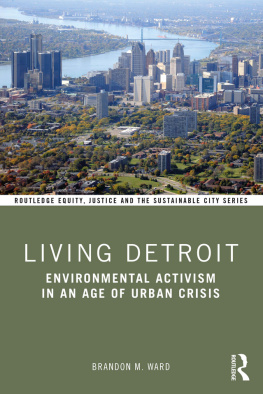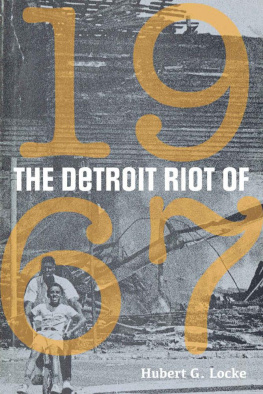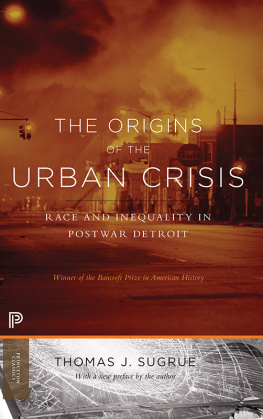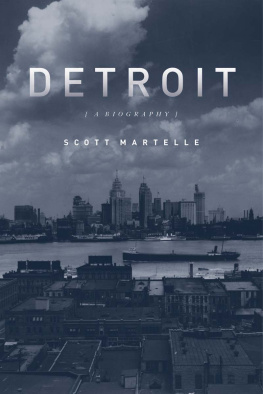
GREAT LAKES BOOKS
A complete listing of the books in this series can be found online at wsupress.wayne.edu.
EDITOR
Charles K. Hyde, Wayne State University
ADVISORY EDITORS
Jeffrey Abt, Wayne State University
Fredric C. Bohm, Michigan State University
Sandra Sageser Clark, Michigan Historical Center
Brian Leigh Dunnigan, Clements Library
De Witt Dykes, Oakland University
Joe Grimm, Michigan State University
Richard H. Harms, Calvin College
Laurie Harris, Pleasant Ridge, Michigan
Thomas Klug, Marygrove College
Susan Higman Larsen, Detroit Institute of Arts
Philip P. Mason, Prescott, Arizona and Eagle Harbor, Michigan
Dennis Moore, Consulate General of Canada
Erik C. Nordberg, Michigan Humanities Council
Deborah Smith Pollard, University of MichiganDearborn
Michael O. Smith, Wayne State University
Joseph M. Turrini, Wayne State University
Arthur M. Woodford, Harsens Island, Michigan
RACE, RELIGION, RELIGION, and the PULPIT
REV. ROBERT L. BRADBY AND THE MAKING OF URBAN DETROIT
JULIA MARIE ROBINSON

Wayne State University Press
Detroit
2015 by Wayne State University Press, Detroit, Michigan 48201.
All rights reserved. No part of this book may be reproduced without formal permission. Manufactured in the United States of America.
Library of Congress Control Number: 2014952941
ISBN 978-0-8143-3291-7 (jacketed cloth)
ISBN 978-0-8143-4037-0 (ebook)
Bradby family photos are reproduced courtesy of Angela Bradby-Greene, Family Historical Collection. Historic photos of Second Baptist Church in Detroit are reproduced courtesy of the Archives Research Center at Second Baptist Church of Detroit.
To my parents,
Edisel H. Robinson and Annetta M. Robinson
&
The Members of Second Baptist Church in Detroit, Michigan
CONTENTS
ACKNOWLEDGMENTS
As the minister of Second Baptist Church of Detroit,... would it be right without any reason at all to break from these who have struggled so hard... to make me what I am?
Rev. Robert L. Bradby
Second Baptist, the first church established for free blacks in the territory of Michigan in 1836, has long stood as a monument of faith and sociopolitical empowerment for black Detroiters. Reverend Robert L. Bradby, Second Baptists nineteenth pastor, was a seminal figure in the churchs illustrious history, especially between 1910 and 1930, when the church held the reputation as the home of strangers. During the first wave of the Great Migration at the turn of the twentieth century, African Americans were seeking a way to escape the inequalities of the South. Making their way northward, many were drawn to Detroits most influential pastor, said to be dedicated to establishing the Kingdom of God among Detroits newcomers. As a modus operandi in the culture of Second Baptist, the Kingdom of God represented a theological understanding of Christian praxis and racial uplift. The theological orientation of the Kingdom blended the promises inherent in the Gospel messages of salvation and the sociopolitical strategies of black uplift. In Detroit, Reverend Bradby proclaimed this Kingdom theology from the pulpit of Second Baptist, which became a transformative ideology that empowered and shaped the citys black urban community.
The intertwined history of Second Baptist, Rev. Robert L. Bradby, and the urbanization of Detroit lies in the familiar settings of church offices, pews, and Sunday school rooms. Old church bulletins, letters, and anniversary booklets tell stories of struggle, faith, and progress. One is always astonished at what materials lie right under ones nose, orin my caseright above my head. I grew up attending services at Second Baptist. The church had three floors, and on the second floor stood the former office of Reverend Bradby. Second Baptists late church historian, Dr. Nathaniel Leach, kept his study in that space. Today, the office door of the late Dr. Leach still holds the name R. L. Bradby, written in faded gold letters.
During the numerous times I sat as a child up in the balcony of Second Baptist, only a few yards from Leachs study, I never realized how much that office and the clutter of papers therein would shape my life and career. It took a graduate assignment at Michigan State University to take me back to the second floor of the church. And it was then that I remembered a story told by my grandfather, William Lensey Robinson. Often, absentmindedly, rotating a disfigured gold ring around what was left of his right index finger, my grandfather would tell the story of how his finger became a nub at the Ford Motor Company stamping plant. Rev. Robert L. Bradbys written recommendation had secured my grandfather a job at Ford Motor Company, an act that marked my grandfathers good standing as a member of Second Baptist. Incidentally, my grandfather named his son, my father, Edisel Henry Robinson. My fathers name echoed the first name of Ford Motor Companys illustrious founder, Henry Ford, and his first son, Edsel Ford. The naming of my father after Henry Ford and his son may have possibly been in tribute to the automotive magnate, or it just might have been the name that appealed best to my grandfather. Whatever the reason, the interwoven stories of my grandfathers experience at Ford Motor Company, my fathers name, Second Baptist, and Reverend Bradby became the basis of my doctoral dissertation and now the narrative you have before you.
I owe much gratitude to Second Baptists most celebrated historian. Baptized by Reverend Bradby in 1924, Dr. Leach became a devout member of Second Baptist Church. Among his many services to the church was the tremendous task of collecting and preserving the churchs phenomenal history. Collecting photos, bulletins, and church minutes, Leach was able to publish the first dissertation on the church, titled The Second Baptist Connection: Reaching Out to Freedom, History of Second Baptist Church of Detroit. By 1977, Leach had enough historical data to establish the church as a historical landmark, highlighting the churchs impressive history as one of the last stages in the Underground Railroad. That same year, Leach organized the Second Baptist Historical Committee, which was charged with preserving the churchs rich history. Leach remained the presiding chair of the committee until his health failed in 2004. The Bentley Historical Library at the University of Michigan, Ann Arbor, has also recognized Dr. Nathaniel Leachs contribution to Second Baptist and Detroits dynamic history by copying much of his work on microfilm. I am incredibly indebted to Dr. Leach and the Second Baptist Historical Committee for taking such care of the churchs historical documents. Despite Leachs untimely death in 2005, his legacy continues to live on in the churchs vibrant history. I am extremely honored to be able to share the story of Second Baptist, or Second, as congregants refer to their historic black church. I am also grateful to the church members of Second Baptist, many of whom provided deeper insight into the personhood of Reverend Bradby.
I owe a great deal of thanks to a number of archivists at the University of Michigans Bentley Historical Library, the Burton Historical Library, and the Benson Ford Research Center, who tirelessly supported this project over the years. I must also thank Gwen S. Robinson, a superb researcher at the W.I.S.H. Centre in Chatham, Ontario, and an officer in the Chatham-Kent Black Historical Society. She placed in my hands some of the most crucial data concerning Robert L. Bradbys Canadian background and members of the black Baptist communities who lived along Ontarios southern borders. Her expertise in the field of African Canadian history and her willingness to help were overwhelming.
Next page










